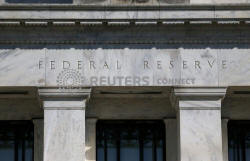Fed faces tricky act balancing impact of vaccines against economic pain
 Send a link to a friend
Send a link to a friend
 [December 16, 2020] By
Howard Schneider [December 16, 2020] By
Howard Schneider
WASHINGTON (Reuters) - The Federal Reserve
on Wednesday will offer its first glimpse of how a coronavirus vaccine
has changed the U.S. economic outlook, and whether businesses, workers
and families need more help from the central bank until inoculations and
immunity are widespread.
The conclusion of the Fed's last policy meeting of 2020 will cap a
tumultuous year in which it slashed interest rates, ramped up bond
purchases and took other extraordinary measures to stem the economic
carnage of the pandemic.
The landscape, however, has changed dramatically since Fed policymakers
held their last two-day meeting in early November, with the rollout of
one COVID-19 vaccine and another one on the way almost certain to boost
the outlook for 2021.

In quarterly economic projections last issued in September, Fed
officials at the median saw the economy growing 4% next year and the
unemployment rate falling to 5.5%. Analysts expect both figures to be
upgraded.
Less clear is what, if anything, the Fed decides to do in the meantime,
including whether to focus its $120 billion in monthly asset purchases
in a way that brings down longer-term interest rates even further, which
could help industries like housing that are keyed to long-term mortgage
loans.
It's a move many in financial markets have called for and expect at some
point, though Fed officials have for the most part said they are not yet
ready to do it.
"The arguments for acting now are solid," said Cornerstone Macro analyst
Roberto Perli, adding that the choice remains "a close, meeting-time
decision."
The coronavirus is spreading rapidly at a pace of more than 200,000 new
infections daily across the country, businesses face the twin challenges
of renewed restrictions and more fearful consumers, and job growth is
slowing - compelling reasons for the Fed to take action.
[to top of second column] |

Federal Reserve Board building on Constitution Avenue is pictured in
Washington, U.S., March 19, 2019. REUTERS/Leah Millis/File Photo

On the other hand, "the promise of vaccines and the possibility of more fiscal
support ... might incline the Fed to wait and see," Perli wrote in a recent
analysis.
Lawmakers in Congress are locked in negotiations over another federal stimulus
package to help ailing firms and families, but a deal has proven elusive so far.
The Fed is due to release its latest policy statement and economic projections
at 2 p.m. EST (1900 GMT). Fed Chair Jerome Powell will hold a news conference
half an hour later.
Analysts expect Powell and his colleagues to provide guidance on one important
aspect of monetary policy: how much longer the Fed might continue and under what
conditions it might reduce its monthly government bond purchases, a flow of
support into financial markets meant to help hold down borrowing costs for
consumers and businesses.
The central bank's federal funds rate - its benchmark overnight lending rate -
has been near zero since March, so the bond purchases are now its nearest tool
at hand to influence the economy.

Just as rates are not expected to rise for perhaps several years, analysts
expect the Fed to tie any reductions in its bond-buying to substantial
improvement in the economy - likely pushing off any "taper" of its asset
purchases until late next year or beyond.
(Reporting by Howard Schneider; Editing by Dan Burns and Paul Simao)
[© 2020 Thomson Reuters. All rights
reserved.] Copyright 2020 Reuters. All rights reserved. This material may not be published,
broadcast, rewritten or redistributed.
Thompson Reuters is solely responsible for this content. |